The project is called Rocaille, by Benjamin Dillenburger. No date was specified in the project.
His project seems to be reminiscent of shapes and patterns similar to shells. What I admire about this is the amount of detail in this project. Each surface is created with multiple small twigs of plastic. While I am not sure what algorithms are used to create this piece of artwork, but it seems to remind me fractals and creating smooth surfaces with numerous discrete pieces. The artist seems to have a style for creating very curvy and smooth structures through mathematical and calculated means. We often do not think about art as a very mathematical and calculated way, but this is equally beautiful and logical.
Category: LookingOutwards-03
dnoh-sectionD-lookingoutwards-03
title: ICD + ITKE Research Pavilion 2011
location: Germany
date: 2011
architects (teams): Institute for Computational Design and Institute of Building Structures and Structural Design
I believe that this pavilion was created with a main framework and overlaid with hexagonal shapes. The algorithm found constantly optimizes data to set the geometries into an ideal form.
I find this structure so fascinating because of the beauty in the joinery and details of the hexagons. It’s interesting how the algorithm created such a biological overall form out of geometric shapes that were created with programs.
The initial design was based around the notion of a sand dollar. This notion is clearly seen through the interior holes popped out of the wooden hexagons. The shape is clearly a manifestation of the biological motif.
ssontag-Looking Outwards-03
Being an Architecture major, we discuss parametric design and digital fabrication quite often because it is the most groundbreaking technology in the field. Earlier this year we were introduced to a project done by a professor and group of researchers at MIT. I especially appreciate this project because it not only uses the most recent technology in parametric design and digital fabrication, but it uses a natural precedent to inform the structure of the weave for the panels. Using data collected by the research done on the silkworms, the CNC machine was programmed to weave a unique pattern on each panel that created a pavillion with ample lighting and enclosure.
Matthew Erlebacher Looking Outward-03
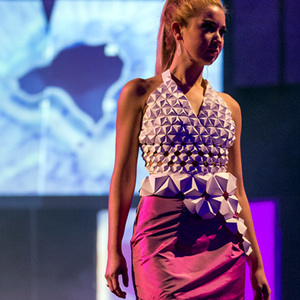
The piece of generative art that I found to be the most interesting was Lustre. I have never been a big fan of fashion but this image struck me. Using a 3D printer to add accessories to a dress is something that I never would have thought of. The algorithms used to create the model were likely set up to create multiple triangular pyramids that were all interconnected. On the whole the piece is mesmerizing to look at and I can’t help but admire how much work went into it.
This was worked on by Carolina Tamayo, Alyssa Hamilton, and Rehan Butt. Unfortunately, the only thing on the piece that I could find was this picture.
thlai-LookingOutwards-03
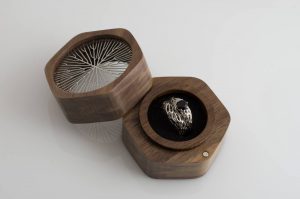
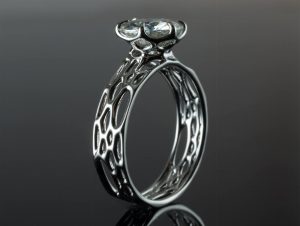
Custom Jewelry – Nervous System
All of Nervous System’s (a generative design studio) projects are intriguing and inspired by natural phenomena, but their custom jewelry in particular caught my eye. These beautiful rings are truly one of a kind, as each fuses together art, science, and technology. Nervous System’s rings are inspired by natural phenomena such as cells and coral, and they are first 3D printed in wax then cast in metal.
What I admire most about Nervous System’s work is how many of their jewelry pieces are co-created with the client, meaning the client had a large role of co-designing via Nervous System’s app, Cell Cycle. Not much information is given on their process and the algorithms used to build their pieces, but their generative work is always grounded by their fascination of organic shapes and unconventional geometries, as stated in their biography. They design a system that generates these natural forms to create all sorts of pieces of art, and as generative art is, each piece is different than the last.
When I look at all of Nervous System’s work, it’s clear that they take a liking to certain patterns – a lot of their work look like nerves or coral – yet each is distinctive. That’s the beauty of generative artwork.
ifv-Looking-Outwards-03
MIT’s Self-Folding Origami Technology
Creators create designs digitally that when printed and inflated with air they self-fold into origami forms.
After reading the prompt this project immediately came to mind. I admire the gesture of taking a step towards creating technology that can completely assemble itself. This technology could be used not only for artistic purposes but also for practical functions, the video above addresses this by saying these principles could be applied to the design of airbags. The materials and designs used consciously imitate the aesthetics and traditions of origami. As the program for designing is developed I hope there becomes a way to make more randomized forms which can still have a significant transformation. After doing some more research I found this video which shows that the project has taken a a turn for practicality and autonomy.
Sheenu-Looking Outwards 3

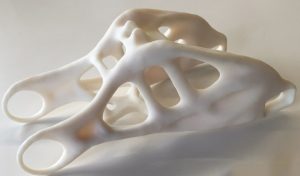

What you’re looking at are parts for a motorcycle made from algorithms in Autodesk’s software. According to Autodesk’s resident futurist Jordan Brandt, computers can help you create the ideas in your head faster and better.
Whether designing a building or a trashcan with certain criterion and aspects we want, computers with algorithms can help design them better because unlike people, computers have no bias. They simply have the goal to make what you want. “But a machine-Autodesk’s software, in this instance-is an unbiased agent.”[It’s] simply looking to optimize the criteria we set forward”.
With Autodesk’s algorithmic software, lighter and more organic looking motorcycle parts can be made. Not only will they make the bike perform better, but also look better. The software can also be used to design much better and smaller lattice structures for medical applications; working far better compared to other medical lattice structures that exist.
I find it interesting and inspiring that parts for machines and bodies that look so artistic and organic can also perform better than other parts. I used to believe that art and strength cannot mix well together. Either it be artistic and fragile or ugly and sturdy. I think it’s great that Autodesk is finding a way to bridge the gap between art and function along with man and machine. It will help creators out there to create.
dayoungc- Looking Outwards -03
“Making Information Beautiful”
This week, I was inspired by the work of David Wicks <sansumbrella.com>, who explores data visualization. I was struck specifically by his project “Drawing Water” <http://sansumbrella.com/works/2011/drawing-water/>, first because of its beauty and second because of how effective it is in helping people experience information in a new way.
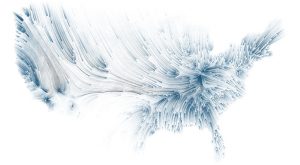
http://sansumbrella.com/works/2011/drawing-water/winter2011.jpg
“A representation of rainfall vs. water consumption in Winter 2001.”
In the print representation above, lines going from blue to black represent the general direction of rainfall toward where it is consumed. Although Wicks cautions that the pathways themselves are imagined, he uses real data: Wicks uses water consumption data from the United States Geological Survey and rainfall data from the NOAA National Weather Service. He inputs this information into code that visualizes rain sources going toward areas of water consumption.
<iframe src=”https://player.vimeo.com/video/24157130″ width=”640″ height=”360″ frameborder=”0″ webkitallowfullscreen mozallowfullscreen allowfullscreen></iframe>
“A video showing a dynamic and interactive representation of the Drawing Water project.”
This is fascinating, as it allows viewers to see and understand data that would otherwise be mere numbers on a page. Only scholars would be able to understand the information properly. But Wicks allows normal people to comprehend it through a printed image generated through computation.
agusman-LookingOutwards-03: 4D Printing



The emergence of “4D printing”
Artist/Scientist: Skylar Tibbits
TED Talk: “The Emergence of 4D Printing”
When I observe the rapid pace at which technology and hardware is evolving, I have to think of all the technology and hardware that becomes immediately discarded as a result. The materials that we have used to build our homes, cities and products cannot provide us much more than what their static form allows, other than the ways we can use that form for creative reuse. So what will happen when our environment changes faster than we can build the proper tools and technologies?
Skylar Tibbits, Co-Director and founder of the Self-Assembly Lab at MIT, is proposing the manufacture and use of “programmable” materials that adapt to the changing environment. He calls this material phenomenon “Self-Assembly” and defines it as a process by which “disordered parts build an ordered structure through local interaction.” By creating responsive building blocks that are constructed and reconstructed by using small amount of energy and interaction, people can build tools that suit the needs of a changing environment. Skylar and his team have been building these “responsive building blocks” with the aid of 3D printing. He calls this process of printing self-constructing objects “4D printing”, as the 4th dimension is the element of change over time.
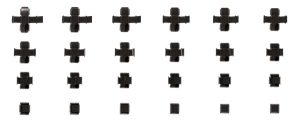
ctv-Looking Outwards-03

http://www.materialecology.com/projects/details/gemini
Neri Oxman’s work at Mediated Matter lab has fascinated me for years. This piece specifically intrigues me, a product designer. Computational design comes into play with many aspects of this form. One fascinating algorithm used in this project is a pressure-point mapper. The researchers used a computer vision (and other) programs to map the back of the human body. The orange and yellow bulges in this piece are 3d printed from materials of different squishinesses. The algorithm mapped a squishier material to pressure points on the body. I love this piece because an algorithm also determines the amount of each material to print. Her other work also is within the realm of 3d printed. One project is 3d printed bacteria within a 3d printed algorithmically-generated ecosystem.
![[OLD FALL 2017] 15-104 • Introduction to Computing for Creative Practice](https://courses.ideate.cmu.edu/15-104/f2017/wp-content/uploads/2020/08/stop-banner.png)